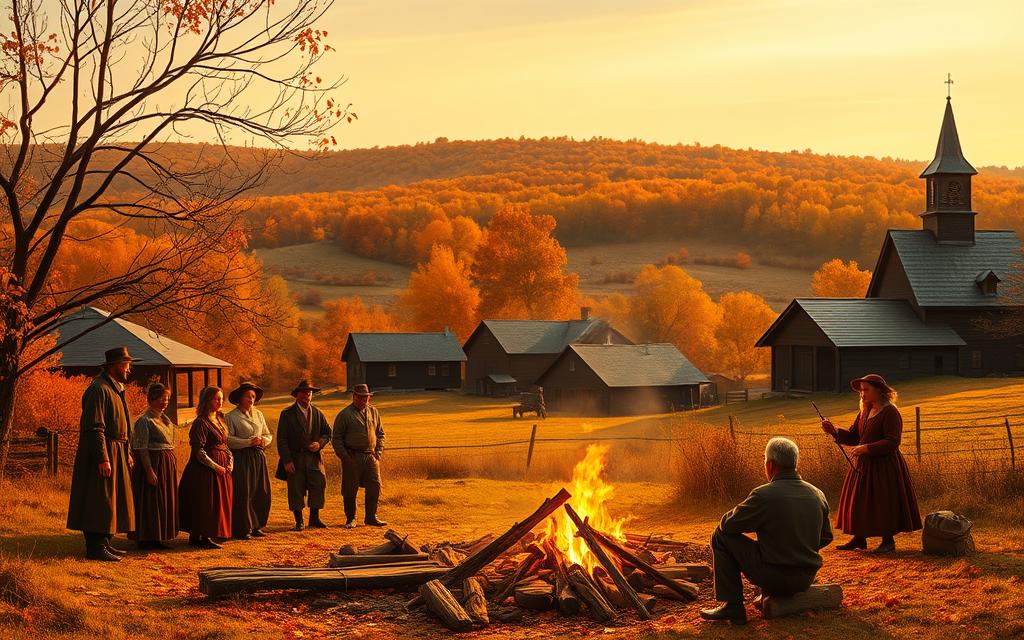As autumn leaves begin to change and the air grows crisper, many of us can’t help but feel a sense of nostalgia and excitement. Fall is a season steeped in history and tradition, from harvest festivals to significant historical events.
The historical significance of autumn is multifaceted, with various cultures celebrating the season in unique ways. For instance, the history of pumpkin spice is closely tied to the harvest season, symbolizing the abundance of autumn.
As we explore the most famous historical events of fall, we’ll discover how this season has shaped our collective past and continues to influence our present. From pivotal battles to cultural celebrations, autumn has played a significant role in shaping history.
The Historical Significance of Autumn
Throughout the ages, autumn has been a time of harvest, celebration, and significant historical events that continue to impact us today. The season has played a crucial role in shaping cultures and influencing the course of human history.
Why Fall Has Been Pivotal Throughout History
Autumn has been pivotal throughout history due to its association with harvests and the changing of the seasons. Harvest festivals have been a common occurrence, marking the end of the agricultural cycle and the beginning of preparations for the coming year. These festivals have often been tied to significant historical events.

Harvest Traditions and Their Impact on Historical Events
Harvest traditions have had a lasting impact on historical events, influencing everything from ancient agricultural practices to modern-day celebrations. The table below highlights some key harvest traditions and their historical significance.
| Tradition | Historical Significance | Cultural Impact |
|---|---|---|
| Harvest Festivals | Marked the end of the agricultural cycle | Influenced modern-day Thanksgiving celebrations |
| Thanksgiving | Originated as a harvest celebration | Continues to be a significant cultural event in the United States |
| Autumnal Equinox Celebrations | Marked the changing of the seasons | Influenced ancient cultures and their agricultural practices |
These harvest traditions have contributed to the rich tapestry of autumn’s historical significance, continuing to influence our cultural practices today.
Ancient Autumn Celebrations and Events
Autumn has been a pivotal time in many ancient cultures, marked by various celebrations and events. The season’s significance is deeply rooted in fall traditions that have been passed down through generations.

Celtic Samhain and Roman Pomona Festivals
The Celts celebrated Samhain, marking the end of the harvest season and the beginning of winter. This festival was believed to be a time when the boundary between the living and the dead became blurred. In contrast, the Romans celebrated the festival of Pomona, the goddess of fruit and trees, highlighting the importance of the harvest season.
Fall Equinox Celebrations Across Ancient Civilizations
The fall equinox was a significant event in many ancient cultures, often celebrated with rituals and ceremonies. For example, the ancient Mayans built elaborate temples to honor the equinox, while in Japan, the autumnal equinox is still celebrated as a national holiday, known as Shūbun no Hi. These autumn historical events showcase the season’s importance in fall history.
These ancient celebrations not only highlight the cultural significance of autumn but also demonstrate how the season has been a constant presence in human history, influencing various aspects of society and culture.
Colonial America’s Autumn Milestones
In the early days of American colonization, autumn brought crucial moments that defined the future. The season, often associated with harvest and change, played a significant role in shaping the course of history.

The Mayflower’s Arrival in November 1620
The arrival of the Mayflower in November 1620 marked a pivotal event in American history. After a grueling journey across the Atlantic, the Pilgrims established the Plymouth Colony, which became a cornerstone of American settlement. This event is a significant seasonal historical highlight, demonstrating the challenges and triumphs faced by early settlers.
The Mayflower Compact, signed before landing, established a framework for governance, showcasing the Pilgrims’ commitment to creating a functional society. This autumn milestone laid the groundwork for future colonization efforts.
The First Thanksgiving: Separating Fact from Fiction
The first Thanksgiving, often associated with the fall season, is a topic of much historical debate. While popular culture portrays it as a harmonious feast between the Pilgrims and Native Americans, the actual events were more complex. The harvest celebration in 1621 was indeed a significant event, but it was not necessarily the first “Thanksgiving.”
Understanding the historical context and autumn historical happenings surrounding this event is crucial. It was a time of cooperation and celebration, but also marked the beginning of complex interactions between European settlers and Native American populations.
These fall season historical milestones continue to be celebrated and studied today, offering insights into the challenges and opportunities faced by Colonial America.
Revolutionary Fall: Autumn During America’s Fight for Independence
In the fall of 1777, the Continental Army achieved a decisive victory that would change the trajectory of the war. This pivotal moment in American Revolutionary War history is a testament to the bravery and resilience of the American forces.
The Battle of Saratoga: October’s Turning Point
The Battle of Saratoga, fought in October 1777, was a crucial turning point in the war. The Continental Army’s victory over the British forces marked a significant shift in momentum, convincing France to ally with the Americans. This battle is considered one of the most important in the war.
| Event | Date | Significance |
|---|---|---|
| Battle of Saratoga | October 1777 | Turning point in the war, French alliance |
| Fall of 1781: Yorktown | September-October 1781 | British defeat, path to victory |
Fall of 1781: Yorktown and the Path to Victory
The fall of 1781 saw the culmination of the American Revolutionary War with the surrender of British forces at Yorktown. This decisive victory, led by General George Washington, trapped the British army, leaving them no escape. The victory at Yorktown effectively ended the war, paving the way for American independence.
The autumn season played a significant role in autumn history and fall historical milestones, marking crucial moments in the fight for American freedom. The events of 1777 and 1781 remain pivotal in understanding the course of the American Revolutionary War.
Beyond the Pumpkin Spice: A Look at Fall’s Most Famous Historical Events in the 19th Century
During the 19th century, the fall season witnessed crucial historical milestones that continue to influence America today. The autumn months brought significant events that shaped the nation’s history, from presidential proclamations to the birth of new sports traditions.
The October Surprise: Lincoln’s Emancipation Proclamation
One of the most pivotal events in the fall of the 19th century was President Abraham Lincoln’s Emancipation Proclamation, issued on January 1, 1863, but its impact was felt throughout the autumn of that year. Although not directly an autumn event, its reverberations were significant during the fall season. The proclamation declared freedom for all slaves in Confederate territory, marking a crucial turning point in the Civil War and changing the course of American history.
This move not only had immediate effects on the war but also laid the groundwork for the eventual abolition of slavery with the 13th Amendment. The Emancipation Proclamation is an iconic fall event in American history, symbolizing a step towards a more unified and equitable society.
The Birth of Football Season and Fall Sports Traditions
The 19th century also saw the emergence of football as a popular fall sport in America. The first intercollegiate football game was played in 1869 between Rutgers and Princeton universities, marking the beginning of a beloved fall tradition. As the season progressed, colleges across the country began to adopt the sport, establishing it as a staple of autumn.
Football season became synonymous with fall, bringing communities together and creating a shared cultural experience. The sport’s growth during this period contributed to the development of other fall sports traditions, cementing the season’s place in American cultural identity.
The historical significance of fall is evident in these 19th-century events, from Lincoln’s Emancipation Proclamation to the birth of football season. These autumn historical celebrations and iconic fall events continue to shape American culture and history.
World-Changing Autumn Events of the 20th Century
As the leaves changed colors, the world was witness to events that would alter the course of history forever. The 20th century, in particular, was a time of significant fall events in history that had lasting impacts on society.
The autumn season has long been associated with change, and the 20th century was no exception. It was a period marked by pivotal moments that shaped the world as we know it today.
The Wall Street Crash of 1929: Black Tuesday
One of the most iconic fall events in history is the Wall Street Crash of 1929, also known as Black Tuesday. On October 29, 1929, stock prices plummeted, leading to a global economic downturn known as the Great Depression. This event had a profound impact of fall events on society, leading to widespread unemployment and economic hardship.
Fall of the Berlin Wall: November 1989
Sixty years later, another autumn event would change the course of history. The fall of the Berlin Wall in November 1989 marked the beginning of the end of the Cold War and the division of Europe. This event symbolized freedom and the collapse of communist regimes across Eastern Europe.
The Origins of Pumpkin Spice and Its Cultural Phenomenon
On a more cultural note, the origins of Pumpkin Spice, a flavor associated with autumn, have become a significant historical fall tradition. Introduced by companies like Starbucks in the late 20th century, Pumpkin Spice Lattes have become a seasonal phenomenon, symbolizing the commercialization of fall traditions.
| Event | Date | Impact |
|---|---|---|
| Wall Street Crash of 1929 | October 29, 1929 | Global economic downturn |
| Fall of the Berlin Wall | November 9, 1989 | End of the Cold War |
| Pumpkin Spice Introduction | Late 20th Century | Cultural phenomenon |
These events highlight the significance of autumn in shaping our history and cultural practices. From economic crises to cultural phenomena, the impact of these events continues to be felt today.
Conclusion: The Enduring Legacy of Fall in Shaping Our History
The fall season is more than just a time for cozy sweaters and pumpkin spice lattes; it’s a period steeped in historical significance. Throughout this article, we’ve explored the notable events in autumn that have shaped the course of history.
From ancient autumn celebrations like the Celtic Samhain and Roman Pomona festivals to the pivotal events of Colonial America, such as the Mayflower’s arrival and the First Thanksgiving, fall history highlights are diverse and far-reaching.
The Revolutionary era saw crucial battles like Saratoga and Yorktown, while the 19th century brought significant milestones like Lincoln’s Emancipation Proclamation and the birth of football season. In the 20th century, events like the Wall Street Crash of 1929 and the Fall of the Berlin Wall in 1989 left lasting impacts on the world.
These famous events in autumn demonstrate the fall historical significance and its role in shaping our world. As we enjoy the changing leaves and seasonal festivities, we honor the legacy of those who came before us and the events that continue to influence our lives today.







